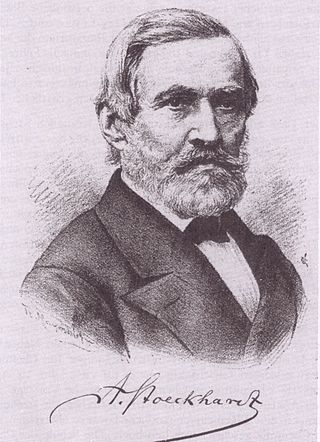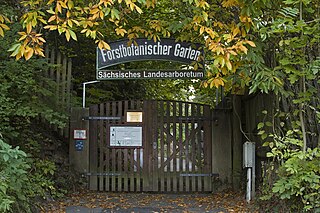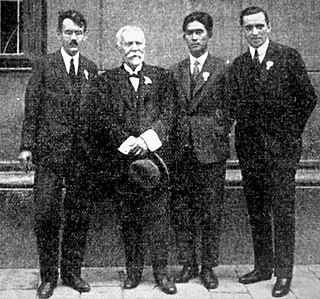TU Dresden (for German: Technische Universität Dresden, abbreviated as TUD and often called the Dresden University of Technology is a public research university in Dresden, Germany. It is the largest institute of higher education in the city of Dresden, the largest university in Saxony and one of the 10 largest universities in Germany with 32,389 students as of 2018.
Samuel Friedrich Nathaniel Ritter von Stein was a German entomologist. He was Professor at the Royal Saxon Academy of Forestry in Tharandt from 1850–55; and Professor, and later Rector, at the Charles University in Prague, from 1855–76. His scientific work focused on invertebrates, and mainly on Diptera.

Tharandt is a municipality in Saxony, Germany, situated on the Weißeritz, 9 miles southwest of Dresden.

The Gottfried Wilhelm Leibniz Prize, or Leibniz Prize, is awarded by the German Research Foundation to "exceptional scientists and academics for their outstanding achievements in the field of research". Since 1986, up to ten prizes have been awarded annually to individuals or research groups working at a research institution in Germany or at a German research institution abroad. It is considered the most important research award in Germany.
Otto Antonius was director of the Tiergarten Schönbrunn in Vienna, zoologist, palaeontologist and co-founder of the modern zoological biology.
Karl Hermann Christian Jordan was a German entomologist and gymnast who competed in the 1912 Summer Olympics. He was born in Papstdorf, Saxony. In 1912 he was a member of the German team which finished fourth in the team, free system competition and fifth in the team, European system event. Jordan was also a professor of zoology, with six species of heteroptera named after him.

Julius Adolph Stöckhardt was a German agricultural chemist. He is mostly recognized for his work on fertilizers, fume damage of plants and his book Die Schule der Chemie, which was translated into 14 languages. His 500 lectures and over 500 publications helped to establish agricultural chemistry in Germany.

Johann Heinrich Cotta, also Heinrich von Cotta, was a German silviculturist who was a native of Kleine Zillbach, near Wasungen, Thuringia. He was founder of the Royal Saxon Academy of Forestry, in Tharandt, and is known as a pioneer of scientific forestry. He was the father of the geologist Bernhard von Cotta (1808–1879).

The Forstbotanischer Garten Tharandt, also known as the Sächsisches Landesarboretum, is an arboretum maintained by the Dresden University of Technology. It is among the oldest arboreta in the world, and is located at Am Forstgarten 1, Tharandt, Saxony, Germany, and open daily except Friday in the warmer months.

The Tharandt Forest is a landscape in the centre of the German Free State of Saxony and lies southwest of the forest town of Tharandt, south of the town of Wilsdruff, roughly between the cities of Freiberg and Dresden. Administratively it is fully part of the borough of Tharandt today and bears a legally-protected strapline with the text: Tharandter Wald – schönster Wald Sachsens, which goes back to the tourist advertisements of the 1920s.
The Royal Saxon Academy of Forestry in Tharandt, Saxony, near Dresden, was founded by silviculturist Heinrich Cotta in 1811. Established in conjunction with the school, and later integrated with it, was the Forstbotanischer Garten Tharandt, one of the oldest arboreta in the world. Its legacy lives on today as a campus of the Dresden University of Technology and site of that institution's Department of Forestry.

Hinrich Nitsche was a German zoologist. He was a son-in-law to geographer Oscar Peschel (1826-1875).

Johann Friedrich Judeich was a German forester.

Max Heinrich August Neumeister was a German forestry scientist.
Heinrich August Vater was a German soil scientist and forestry scientist. Vater was a pioneer in the areas of forest soil science, land evaluation, and forest fertilization.
Karl Leopold Escherich was a German entomologist and professor of zoology. Known as a pioneer of applied entomology and expert in termites, he was rector of the University of Munich from 1933 to 1936.

Bekenntnis der Professoren an den Universitäten und Hochschulen zu Adolf Hitler und dem nationalsozialistischen Staat officially translated into English as the Vow of allegiance of the Professors of the German Universities and High-Schools to Adolf Hitler and the National Socialistic State was a document presented on 11 November 1933 at the Albert Hall in Leipzig. It had statements in German, English, Italian, and Spanish by selected German academics and included an appendix of signatories. The purge to remove academics and civil servants with Jewish ancestry began with a law being passed on 7 April 1933. This document was signed by those that remained in support of Nazi Germany.
Andreas Roloff is a German forest scientist.
Arnold Friedrich Victor Jacobi was a German zoologist and ethnologist who worked at the Forest Academy in Tharandt and later served as director of the Dresden Museum. He studied biogeography, described numerous taxa of molluscs, cicadas and wrote on birds and mammals. He was a supporter of the Nazi regime.

Hans Wolfgang Stichel was a German zoologist and entomologist. He wrote book on the identification of bugs. During the Third Reich, he became a member of the NSDAP and served in the Waffen-SS as an Untersturmfuhrer. He was involved in the denouncement of his colleague Walther Arndt who was executed by for holding critical views against the Nazis.











